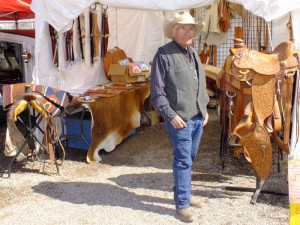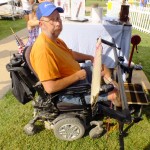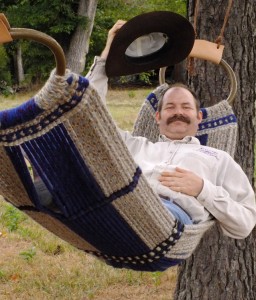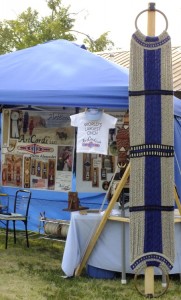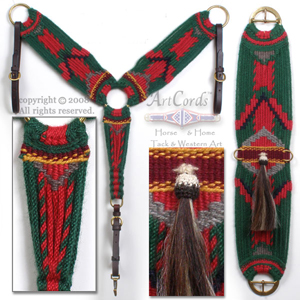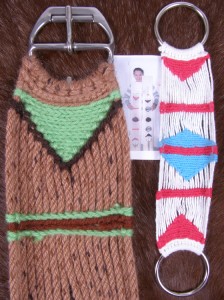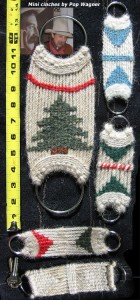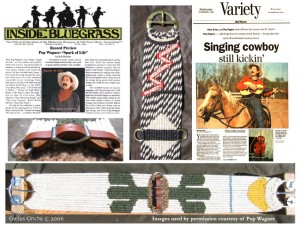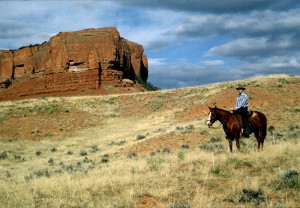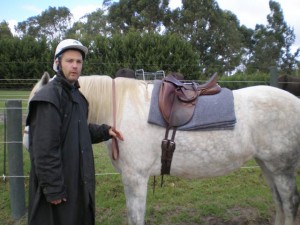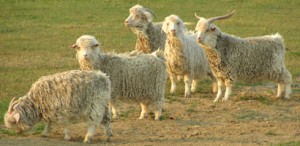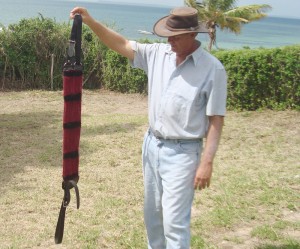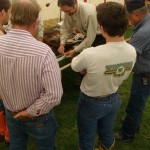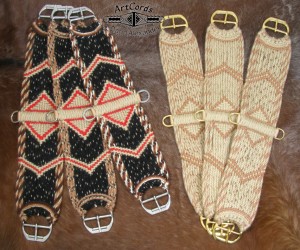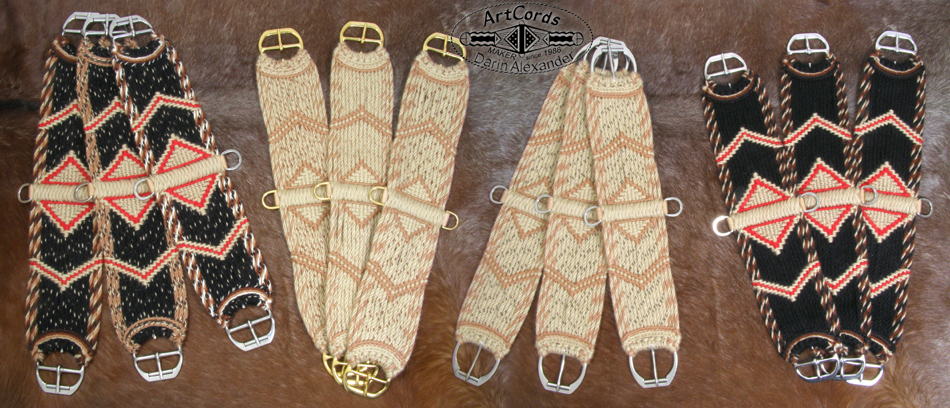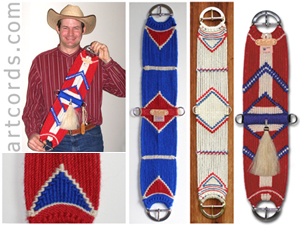It is a joy to see the increasing interest in natural fiber cinches and girths! We have been quite pleased with the response to ArtCords workshops, school programs, multimedia presentations, and adding of horse clinics that there has hardly been a chance for the lawn to grow under our feet the past few months.
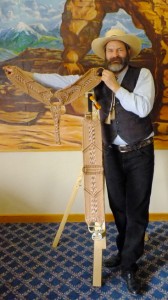 The 2013 venues began with Darin participating in the Colorado Saddle Makers Association – Winter Seminar in Moab, Utah. It is always enlightening to spend time with those in the CSMA as they are so helpful and interested in learning and sharing from their own experience. One of the highlights of the weekend was the chance for folks to touch and feel the World’s Largest Mohair Cinch. Darin continued the finishing work on the Ornate Vaquero and Breast Collar set which had been constructed with participation of several CSMA members during 2012 Seminars beginning with twisting the cords from small yarns on a hand-operated rope machine.
The 2013 venues began with Darin participating in the Colorado Saddle Makers Association – Winter Seminar in Moab, Utah. It is always enlightening to spend time with those in the CSMA as they are so helpful and interested in learning and sharing from their own experience. One of the highlights of the weekend was the chance for folks to touch and feel the World’s Largest Mohair Cinch. Darin continued the finishing work on the Ornate Vaquero and Breast Collar set which had been constructed with participation of several CSMA members during 2012 Seminars beginning with twisting the cords from small yarns on a hand-operated rope machine.

Jay shows a traditional Navajo cinch which employs extensive weaving techniques differing widely in method from the more common ‘cord’ cinches.
On the way to teach cinch making workshops at the Southwest Leather Trade Show in Wickenburg, Arizona, Darin was invited to stop in to visit Jay’s Navajo-Churro Lamb & Wool camp. It is always a pleasure to meet another cinch maker and discuss various fibers and techniques. Jay shared how he first made the 17 strand tied cinch and then asked his grandmother to teach him the traditional Navajo Cinch style, which he now teaches to others to carry on the tradition.
In the process of conducting workshops for the Leather Crafters Journal in Wickenburg, Darin had the honor of sharing his methods of cinch making with yet another Navajo weaver. The workshops are always an opportunity for participants to not only learn from the instructor, but also pick up little details from each other as each individual approaches the project with varying experience and perspectives. Instructors often observe that teaching advances their own aptitude as well as broadening their awareness of additional techniques or methods they otherwise may not have considered.
In addition to providing workshops for the Leather Show attendees, Darin was blessed with the invitation to be introduced to the students and faculty of the Wickenburg Christian Academy the first morning of the workshops, and asked say a few words about cinches and how they relate to the horse and rider. The introduction had been so warmly accepted that the principal scheduled Darin to open the Thursday morning student assembly with a rope making demonstration illustration biblical principles and a devotional thought which students and staff responded to with joy-felt appreciation.
Learning of Equine activities in the Pheonix area that were promoted as ‘Must Visit’ venues, Darin stopped in to learn more and met great folks at both Winter Range and the Arabian Horse Event.
Following a couple of days in the Pheonix area, Darin made his way to Tuscon to meet up with fellow CSMA member and long-time friend, Jesse Smith who provides a saddle school out of his shop in Southeastern Colorado. Imagine the surprise to find substantial snow on the ground and in the cactus and palm trees of Arizona! The photo ops could not be missed…
Returning home to Arkansas, Darin attended to cinch, supplies, and educational materials orders from existing and new clients as well as making preparations for trips to Idaho, Washington, and Wyoming. Elaine returned to Arkansas in the midst of preparations with glowing report of her mothers improved health. Testimony to the benefits of plant-based diet, exercise, and an encouraging environment of friends and family.
In brief the travel to the NW USA included an alumni gathering of high school graduates from the school where Darin learned the cinch making, followed by a few days to meet with family in Washington culminating in a custom project review and planning session with horse trainers on a girth comfort and pain study. The resulting benefits to horse and rider, from the collaboration, which began months before, is now known as the Girth Shield Project and is providing a substantial leap in performance for horses which are being outfitted with the most ergonomically design cinch solution known as the patented “Girth Shield.” Darin is honored to be the exclusive licensee of the concept for natural cord cinches and girths.
 While Elaine remained in Arkansas to continue her training to become a certified therapeutic riding instructor, Darin headed to the 20th annual Sheridan Leather Workers Trade Show. Sheridan has been the longest running venue for Darin to share the ropes of cinch making, hosted each year by the Leather Crafters Journal. Attendance for the cinch workshops increased dramatically this year as word spreads about the progressive approach and ArtCords methods for recognizing how to improve design for functionality and comfort . The Friday workshop attendees were unexpectedly graced with a visit by clinician Buck Brannaman who placed an order for new custom cinches with Darin and kindly stepped in to photos with the Big Mohair Cinch as a backdrop.
While Elaine remained in Arkansas to continue her training to become a certified therapeutic riding instructor, Darin headed to the 20th annual Sheridan Leather Workers Trade Show. Sheridan has been the longest running venue for Darin to share the ropes of cinch making, hosted each year by the Leather Crafters Journal. Attendance for the cinch workshops increased dramatically this year as word spreads about the progressive approach and ArtCords methods for recognizing how to improve design for functionality and comfort . The Friday workshop attendees were unexpectedly graced with a visit by clinician Buck Brannaman who placed an order for new custom cinches with Darin and kindly stepped in to photos with the Big Mohair Cinch as a backdrop.
The second venue in Wyoming was hosted by Central Wyoming Community College. First visit of the cinch workshops to a community or new location may have a relatively few attendees, however the experience gained and realization of how much more there is to discover has prompted the attendees and college representative to request ArtCords Public Education workshops and presentations more than once a year. Efforts are already in motion to meet this and other similar requests.
Between the above travels have also been the periodic personal training of students who schedule to take advantage of the ArtCords studio, complete with rope-walk and various tools and looms for a well rounded experience with various aspects of the cinch and cord-making trades. Many of the students who contact the ArtCords team with excitement about the prospects of learning the cinch and/or rope making, come from all walks of life and levels of experience. It has especially been a real honor to share the traditions with a number of clients who are physically challenged, yet find the cinch making techniques therapeutic and enjoyable to pursue.
July 4, provided the opportunity to share rope making at a booth during the 100 year celebration for the town of Gentry, Arkansas where ArtCords is based. Fitting opportunity to share the ropes on the 21 year anniversary of Darin’s personal involvement with cinch making public education which commenced at a Rodeo in 1992 in Wyoming.
July 7 the Alexanders participated in the Heritage Days Festival at Baker Creek Heirloom Seed Compnay in Mansfield, Missouri. Due to schedule conflicts for a couple of years, the couple had been unable to attend the festivals where they have often provided the popular rope making in association with the cinch education and demonstrations. They very much appreciated reconnecting with the vendors they met before, becoming acquainted with new vendors and those who visited the Bakersville Pioneer Village. Many of the folks who engaged in conversation were from other states, even 1000 miles or more.
We look forward to meeting you along life’s journey! Till next time, “Happy Trails!”

